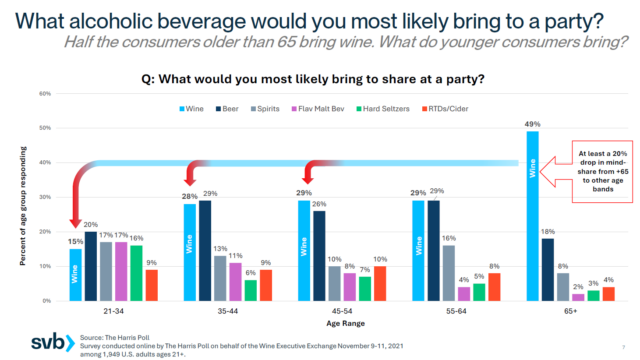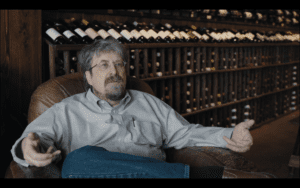If a rising tide floats all boats, then a shrinking tide does the opposite.
By Jeff Siegel
 This year’s Silicon Valley Bank (SVB) state of the wine industry report, released earlier today, pulls no punches. There was good news — premium sales revenue increased substantially — but, overall, the wine business is seeing a drop in demand such as it hasn’t experienced in decades. More specifically, the report calls the change “negative sales volume growth,” as fewer people, especially younger consumers, are buying and drinking wine.
This year’s Silicon Valley Bank (SVB) state of the wine industry report, released earlier today, pulls no punches. There was good news — premium sales revenue increased substantially — but, overall, the wine business is seeing a drop in demand such as it hasn’t experienced in decades. More specifically, the report calls the change “negative sales volume growth,” as fewer people, especially younger consumers, are buying and drinking wine.
“This is obviously a place where none of us want to be,” said Rob McMillan, executive vice president of SVB’s wine division, who authored the report. “If a rising tide floats all boats, then a shrinking tide does the opposite. In that case, we’re in a Darwinian model, where the only way to get business is by taking it from someone else. And that’s obviously a place where we don’t want to be.”
SVB sets the standard
The SVB Wine Industry Report is an annual staple that unflinchingly details the industry from multiple viewpoints. It collects anonymous data from producers, consumers, retailers, on-premise, etc., whose candid assessments — and the skillful analysis of McMillan and his team — help us better understand our current situation and prepare for what’s to come. SVB creates a well-rounded picture of where we are, where we’re going and what roadblocks lie in our path.
In the 2023 report’s introduction, McMillan writes: “The point of looking at industry issues is to start a conversation or shine a spotlight on an issue that should be examined. Hopefully, we are looking around corners and calling out issues before they happen. How can we solve problems without identifying them? Prepare yourself and take a deep breath. There are plenty of critical issues to discuss in this report, and we will.”
Volume growth declines continue
This is the second year in a row that volume growth has declined, something that’s almost never happened over the past 40 years. One bright spot: sales volume is expected to stabilize this year at current levels. But that’s still significantly less than it was before the pandemic.
The reason for the decline is straightforward, McMillan told an international webinar audience, reiterating the same message he’s emphasized over the past couple of reports. The two generations younger than the baby boomers aren’t drinking wine, and expecting them to start drinking wine “just because” is unrealistic.
Most of wine’s demographic growth is still coming from the boomers. “Consumers younger than 60 have a lower share of wine consumption compared to what they did in 2007,” reads the report, while about one-third of those aged 21 to 29 who drink alcohol don’t drink wine. Also worth noting: demand among those 70 to 80 is growing, even as this population is dying off.

Amy Hoopes, Chief Strategy and Growth Officer of The Wine Group, told the audience that everything that had been predicted over the past couple of years had come to fruition. This is evident in what the report calls industry “bifurcation” – the dividing line between who benefits from the cost of a typical bottle of wine. In 2017, beneficiaries included those who made wine that cost more than $9. Today, that bottle cost is $15, so fewer wineries are seeing a positive.
McMillan said this bifurcation was among the most stark he had ever seen.
On-premise struggling
Any help in boosting wine demand almost certainly won’t come from on-premise opportunities, where sales growth remains uneven and where more restaurants are offering beverage menus as opposed to traditional wine lists. This reflects the rising demand among younger consumers for spirits, alternative beverages and better-for-you offerings.
Philana Bouvier, president of importer, wholesaler and marketer Demeine Estates, told the presentation attendees that wine must find a way to reinvigorate its on-premise presence — especially wine by the glass, which she called the wine business’ best marketing for its products. She called on wholesalers to work with wineries to make wine by the glass more affordable.

Other findings
In addition to the revelations above, which led to often contentious confrontations between presenters, here are some other details from the report:
- Supply seems to have stabilized, thanks to three consecutive light grape crops in California. The 2022 crush is expected to come in at 3.7 million tons, slightly larger than the 2021 harvest. The SVB report expects grape and bulk prices to remain stable at present levels in 2023.
However, if there is a larger 2023 harvest, thanks to more rain, all bets are off on pricing given the current weakness in demand.
- The wine business seems ready to weather a recession if one occurs in the next 18 months, thanks to the smaller harvests. But there is concern that excess inventory could lead to rapid discounting in a recession.
- Not surprisingly, winery margins are expected to erode in 2023 as higher costs for labor, insurance, bottles, materials and shipping continue. About half of the study’s survey respondents said they will try to take small bottle price increases this year. Premium producers will have a better chance of making those price increases stick than those who make lower-priced wine.
- Climate change is affecting growing conditions, causing some of the cost increases, with about one-half of survey respondents reporting moderate or worse impact as a result of climate change.
- Insurance coverage remains a key concern. Almost two out of five survey respondents noted an increase in insurance premiums and a decrease in coverage; three percent said they could not obtain insurance at any price.
So it seems we have rough seas ahead, but with the proper information and planning, we can navigate safely. Hopefully, the tide will change directions soon.
_____________________________________________________________________
 Jeff Siegel
Jeff Siegel
Jeff Siegel is an award-winning wine writer, as well as the co-founder and former president of Drink Local Wine, the first locavore wine movement. He has taught wine, beer, spirits, and beverage management at El Centro College and the Cordon Bleu in Dallas. He has written seven books, including “The Wine Curmudgeon’s Guide to Cheap Wine.”

















